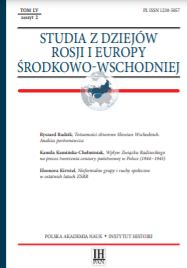Katolicyzm i Wielka Wojna. Upamiętnienie poległych i tożsamościowe konstrukty w Europie Środkowej na przykładzie kościołów św. Jadwigi w Opawie i św. Brunona w Giżycku
Catholicism and the Great War. Commemoration of the Fallen and Identity Constructs in Central Europe on the Example of the Churches of St Hedwig in Opava and St Bruno in Giżycko
Author(s): Jerzy GorzelikSubject(s): Christian Theology and Religion, Recent History (1900 till today), Nationalism Studies, Pre-WW I & WW I (1900 -1919), Politics of History/Memory
Published by: Instytut Historii im. Tadeusza Manteuffla Polskiej Akademii Nauk
Keywords: Catholicism versus nationalism; Silesia in the 20th century; East Prussia; Word War I in memory politics;
Summary/Abstract: In the 1930s, in the borderlands disputed by two rival nationalisms - Czechoslovak Silesia and East Prussia - two Catholic churches were erected to commemorate the fallen in the Great War. Comparison of iconographic programmes, statements made during public rituals and press texts allows to analyse two different identity discourses, which were reflected in both objects. Their common denominator is the reference to the temporal native land, described as Heimat. The fallen are presented as those who sacrificed for the living. In both cases, however, the vision of a community was fundamentally different. In Opava, it had a territorial, supra-ethnic, and even supra-religious character - the monument planned as part of the foundation was to commemorate the fallen of various languages and religions. In Giżycko Heimat was interpreted as the embodiment of the homogeneous Volksgemeinschaft , and East Prussia was shown as an ancient German bastion against Slavic barbarism.
Journal: Studia z Dziejów Rosji i Europy Środkowo-Wschodniej
- Issue Year: 55/2020
- Issue No: 2
- Page Range: 49-65
- Page Count: 17
- Language: Polish

